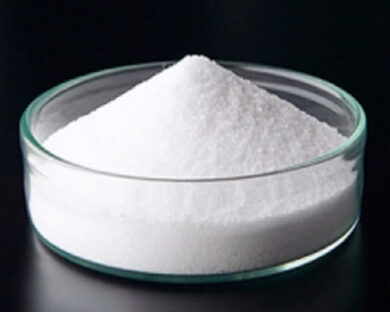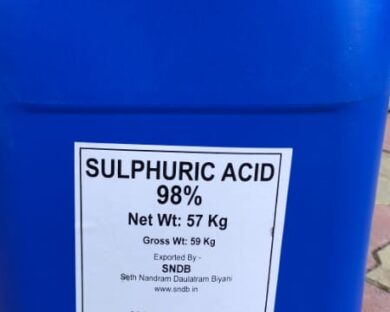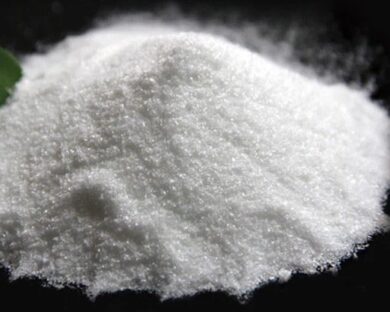Mono Ammonium Phosphate
Mono Ammonium Phosphate
Mono Ammonium Phosphate (MAP) is another name of Ammonium Dihydrogen Phosphate (ADP). MAP is a white crystalline solid, and it is highly water-soluble, but it doesn't turn into liquid when exposed to air or moisture. MAP has the chemical formula (NH4) (H2PO4). It is insoluble in ethanol. It produces an acidic solution of pH 4.7 at 1% concentration. It is a rarely found mineral and occurs as biphosphammite naturally.
MAP can be prepared in the laboratory by the exothermic reaction in the accurate proportions of phosphoric acid and ammonia.
MAP has a wide range of applications in the industry because of its crystalline appearance and structure. Most wide use of MAP is in agriculture as a fertilizer. Fertilizers manufacturers use MAP in tons; over the globe; because it dissolves in soil rapidly and remains stable at temperatures up to 200 °C. It supplies nitrogen and phosphorus to plants which are most important for plant growth and nutrition. Other than agriculture, it has a wide range of uses. MAP is also an essential component of ABC powder in some fire extinguishers. And it also has application in optics due to its birefringence properties. As MAP has a tetragonal crystal structure, it has negative uniaxial optical symmetry. It has typical refractive indices no = 1.522 and ne = 1.478 at optical wavelengths. In crystal manufacturing kits, like amethyst or aquamarine crystals, MAP is present. Mono ammonium crystals are piezoelectric; because of this property, MAP replaced the quartz and Rochelle salt crystals in the 1950s.
Mono ammonium phosphate is hazardous to human skin and eyes because, on decomposition, it releases ammonia and phosphoric acid, which are highly toxic and corrosive and cause ammonia poisoning.
USES AND APPLICATIONS FOR Mono Ammonium Phosphate
INDUSTRIES
It is used in numerous industrial applications like:-
- Fertilizer for crops
- Fire extinguishers
- Optics
- Electronics
- Toys
… and many more.
SNDB Chemicals can provide 99% pure mono ammonium phosphate and quality product for commercial use.
Details of SNDB Chemicals Mono Ammonium phosphate can be found below:-
Mono Ammonium Phosphate is a highly versatile chemical compound widely used in various industries for its exceptional properties and diverse applications. Composed of ammonia and phosphoric acid, MAP is a white crystalline powder with excellent solubility in water, making it easily adaptable for different manufacturing processes.
Key Features:
- High Nutrient Content: Mono Ammonium Phosphate is a rich source of nitrogen and phosphorus, essential nutrients for plant growth and development. Its balanced composition makes it an ideal fertilizer for promoting healthy crop yields and improving soil fertility.
- Water Solubility: Mono Ammonium Phosphate dissolves readily in water, allowing for efficient application through irrigation systems or foliar spraying. This ensures uniform distribution of nutrients to plant roots, maximizing nutrient uptake and minimizing wastage.
- pH Neutral: Mono Ammonium Phosphate has a neutral pH, which helps prevent soil acidity or alkalinity issues commonly associated with other fertilizers. This makes it suitable for a wide range of soil types and crops, promoting optimal growing conditions.
- Quick Release: As a fast-acting fertilizer, MAP provides an immediate nutrient boost to plants, stimulating rapid growth and green foliage. This quick-release feature is particularly advantageous during critical growth stages or when addressing nutrient deficiencies.
- Low Heavy Metal Content: Mono Ammonium Phosphate is manufactured using high-quality raw materials and undergoes stringent quality control measures to ensure purity and safety. It contains minimal levels of heavy metals, meeting regulatory standards and environmental guidelines.
Applications:
- Agriculture: Mono Ammonium Phosphate is extensively used in agriculture as a primary source of nitrogen and phosphorus fertilization. It is suitable for a wide range of crops, including cereals, vegetables, fruits, and ornamentals, promoting healthy plant growth and maximizing yields.
- Horticulture: In horticulture, MAP is employed to maintain nutrient balance in soilless growing media such as hydroponics and aeroponics systems. Its water-soluble nature facilitates precise nutrient management, which is essential for cultivating high-value crops in controlled environments.
- Industrial Uses: Beyond agriculture, MAP finds applications in various industrial processes such as water treatment, flame retardants, and food additives. Its versatility and chemical properties make it a valuable ingredient in diverse manufacturing sectors.
- Fire Retardants: MAP is utilized as a component in fire retardant formulations due to its ability to inhibit combustion and suppress flame spread. It is commonly employed in fire extinguishers, flame-retardant coatings, and firefighting foams for enhanced fire safety.
- Food Industry: In the food industry, MAP serves as a buffering agent, pH regulator, and nutrient supplement in food processing and preservation. It is used in baking, brewing, and dairy products to improve texture, flavor, and nutritional value.
Contact us for Details of SNDB Chemicals.




